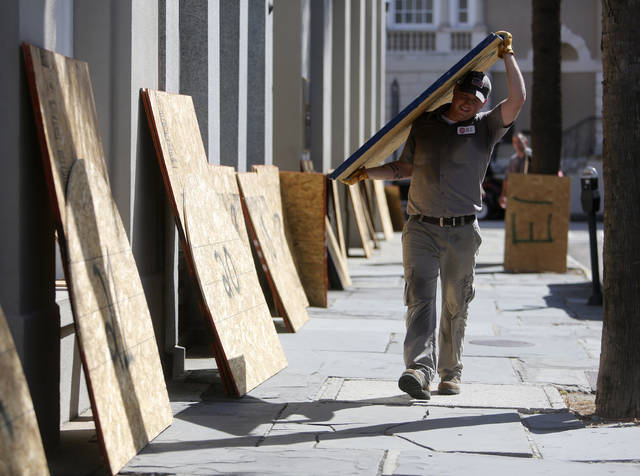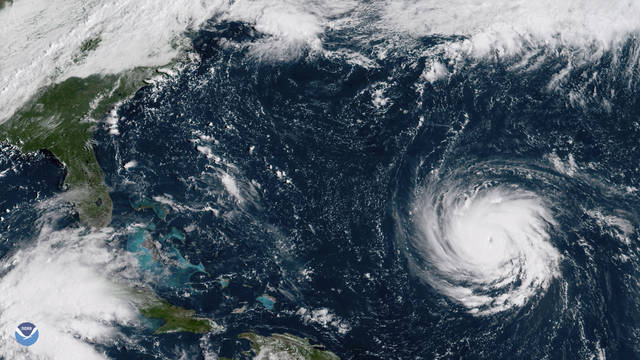RALEIGH, N.C. — Hurricane Florence churned Tuesday toward an Eastern Seaboard landfall as a million people were ordered to leave the coast and millions more prepared for what could be one of the most catastrophic hurricanes to hit the region in decades.
This hurricane’s size is “staggering,” National Hurricane Center Director Ken Graham warned — so wide that 12-foot seas are being pushed 300 miles ahead of its eye and entire states will be deluged for days.
“This one really scares me,” Graham said. “You’re going to get heavy rain, catastrophic life-threatening storm surge, and also the winds.”
There was little change in Florence’s track during the 11 a.m. forecast from the National Hurricane Center. Sustained winds were 130 mph (215 kph) Tuesday morning, but it remains a Category 4 storm and is expected to intensify to near Category 5 status as it slows over very warm coastal waters.
The storm is currently around 400 miles south of Bermuda and is moving at 16 mph (26 kph).
The center of the massive storm is forecast to make landfall late Thursday or early Friday along a stretch of coastline already saturated by rising seas, and then meander for days, inundating several states and triggering life-threatening floods.
Seven-day rainfall totals are forecast to reach 10 to 20 inches over much of North Carolina and Virginia, and even 30 inches in some places. Combined with high tides, the storm surge could swell as high as 12 feet.
“The water could overtake some of these barrier islands and keep on going. With time, the wind pushes the water into every nook and cranny you can think of,” Graham said. “All you have to do is look up at your ceiling, and think about 12 feet (of water). That, folks, is extremely life-threatening.”
President Donald Trump declared states of emergency for North and South Carolina, facilitating federal help, and canceled campaign events Thursday and Friday, citing the storm.
“Please be prepared, be careful and be SAFE!” Trump tweeted, adding: “WE are here for you.”
North Carolina Gov. Roy Cooper said his state is “in the bullseye” and urged people to “get ready now.”
The very center of that bullseye may be Camp Lejeune, the sprawling Marine Corps training base, where authorities were opening emergency operation centers, staging equipment and urging families on the base to build survival kits with food and equipment needed to sustain themselves for 72 hours.
Mandatory coastal evacuations were in effect for civilians in South Carolina, North Carolina and Virginia, but the military base posted on Facebook that different chains-of-command would decide whether to release non-essential personnel, and some relatives vented fears that they wouldn’t be able to evacuate in time.
Florence could hit the Carolinas harder than any hurricane since Hazel packed 130 mph (209 kph) winds in 1954. That Category 4 storm destroyed 15,000 buildings and killed 19 people in North Carolina. In the six decades since then, many thousands of people have moved to the coast.
Ahead of Florence’s arrival, barrier islands were already seeing dangerous rip currents and seawater flowed over a state highway — the harbinger of a storm surge that could wipe out dunes and submerge entire communities.
Watches in effect Tuesday forecast a storm surge of up to 12 feet at high tide from Cape Fear to Cape Lookout in North Carolina. A hurricane watch was in effect for Edisto Beach, South Carolina, to Virginia’s southern border, with the first hurricane-force winds arriving late Thursday.
For many people, the challenge could be finding a safe refuge: If Florence slows to a crawl, it could bring torrential rains all the way into the Appalachian mountains and as far away as West Virginia, causing flash floods, mudslides and other dangerous conditions in places that have already experienced lots of rain recently.
“This is going to produce heavy rainfall, and it may not move very fast. The threat will be inland, so I’m afraid, based on my experience at FEMA, that the public is probably not as prepared as everybody would like,” said Craig Fugate, former director of the Federal Emergency Management Agency.
Florence’s projected path includes half a dozen nuclear power plants, pits holding coal-ash and other industrial waste, and numerous hog farms that store animal waste in massive open-air lagoons. Duke Energy spokesman Ryan Mosier said operators would begin shutting down nuclear plants at least two hours before hurricane-force winds arrive.
All signs pointed to a stronger, slower, wider and wetter hurricane in the days ahead, forecasters said.
A warm ocean gives hurricanes their fuel, and Florence is moving over an area with water temperatures nearing 85 degrees (30 Celsius), hurricane specialist Eric Blake wrote. With little wind shear to pull the storm apart, hurricane-strength winds have been expanding to 40 miles (64 kilometers) from the eye of the storm, and tropical-storm-force winds 150 miles from the center. Information gathered Tuesday by a hurricane-hunting aircraft suggests it will intensify again as it nears the coast, approaching the 157 mph (253 kph) threshold for a worst-case Category 5 scenario.
Two other storms were spinning in the Atlantic as the 2018 hurricane season reaches its peak. Isaac became a tropical storm again approaching the Caribbean, while Hurricane Helene was veering northward, no threat to land.
In the Pacific, Olivia became a tropical storm again, on a path to hit the Hawaiian islands early Wednesday.
Airlines, including American, Southwest, Delta and JetBlue, have begun letting affected passengers change travel plans without the usual fees.
Liz Browning Fox was planning to ride out the storm on the Outer Banks, defying evacuation orders. She said it was built in 2009 in Buxton, North Carolina, up on a ridge, and made to withstand a hurricane. But even the most secure homes could be surrounded by water, or penetrated by wind-launched debris.
“You never know, there could be tree missiles coming from any direction,” she said. “There is no way to be completely safe,” but going inland might not be much safer. “I don’t know where to go from here,” she said.
———
Associated Press writers Seth Borenstein in Washington; Jennifer Kay in Miami; Jeffrey Collins and Meg Kinnard in Columbia, South Carolina, Jeff Martin in Atlanta and Tamara Lush in St. Petersburg, Florida, contributed to this report.
———
For the latest on Hurricane Florence, visit https://www.apnews.com/tag/Hurricanes .



